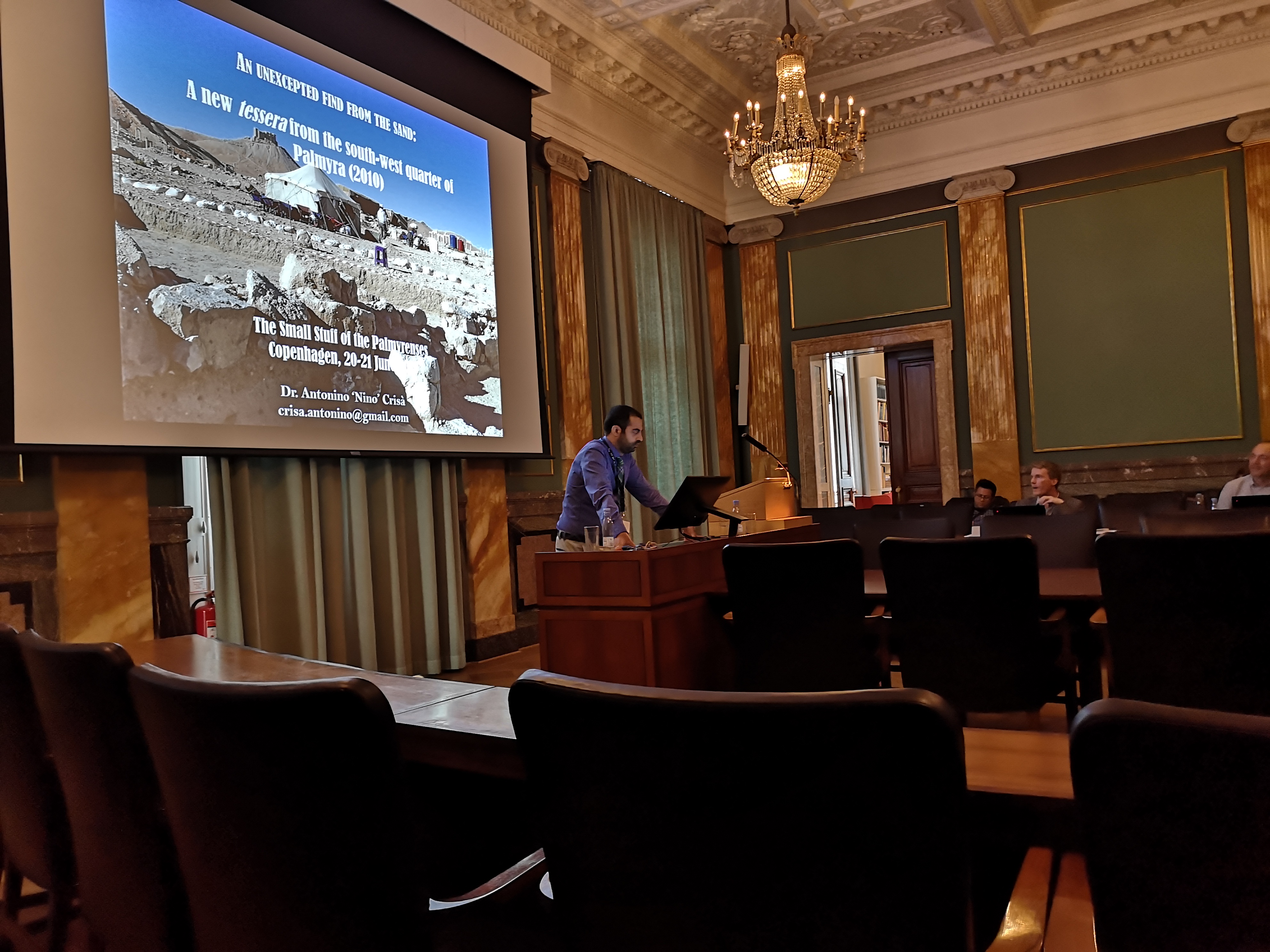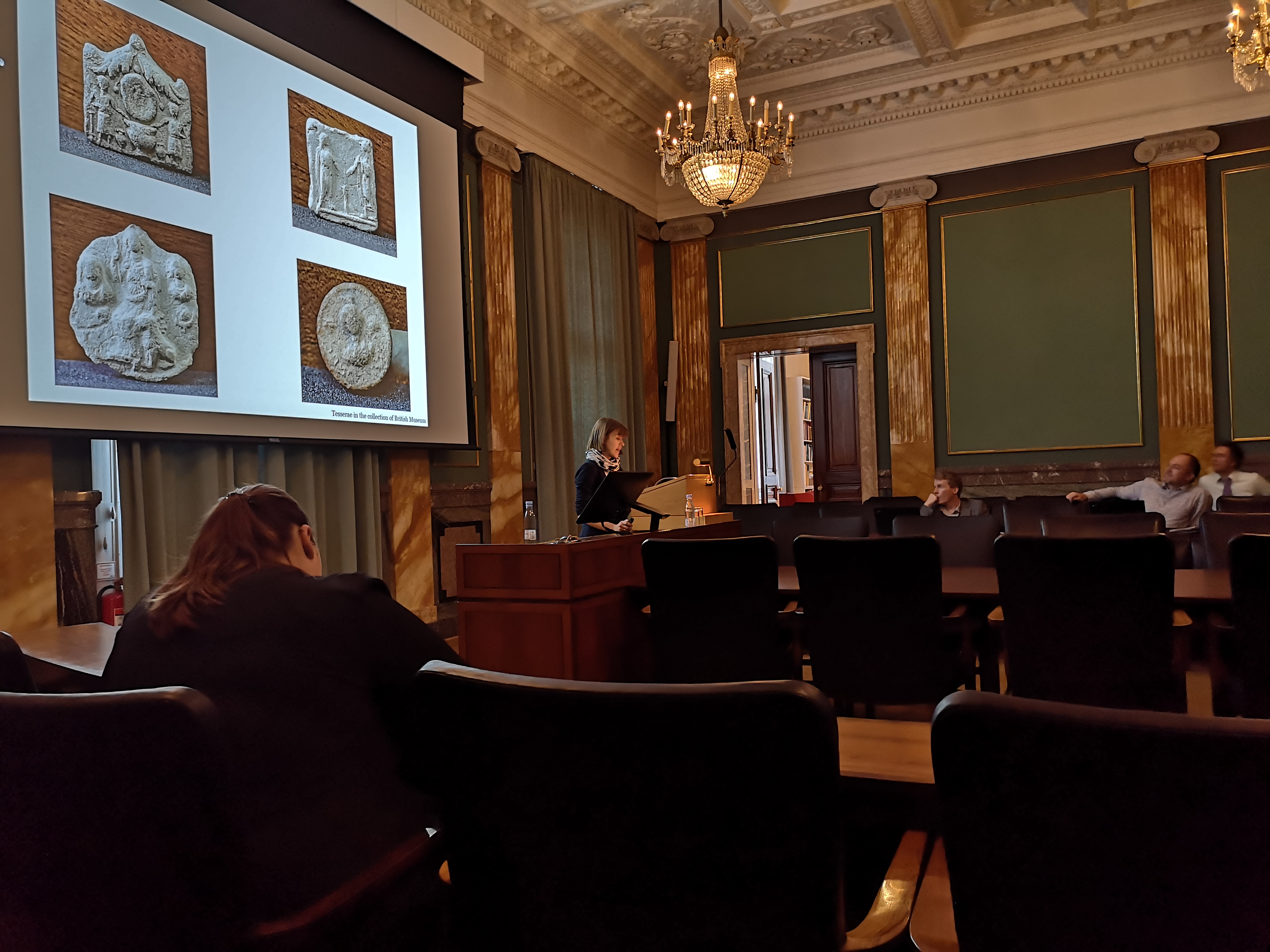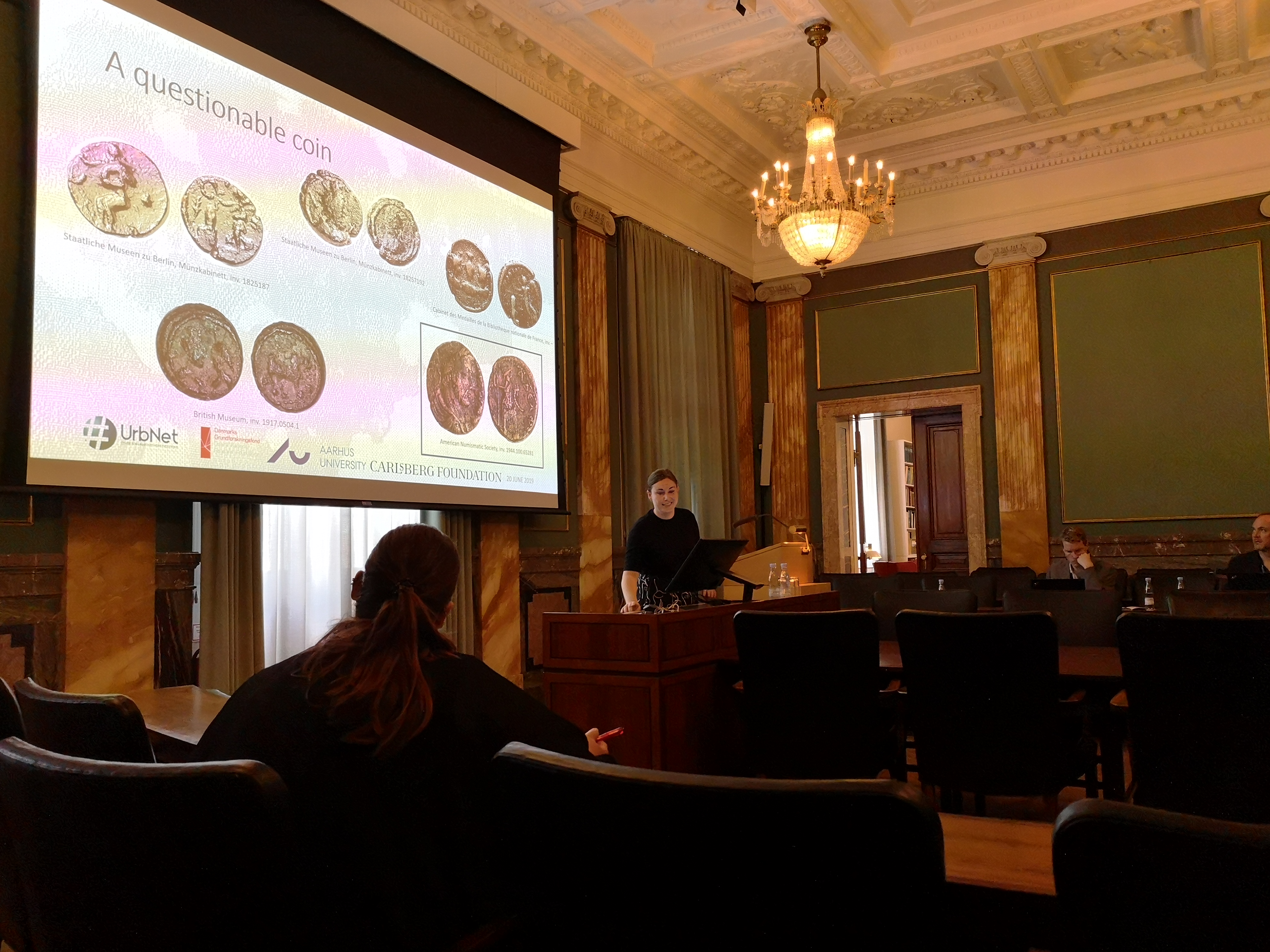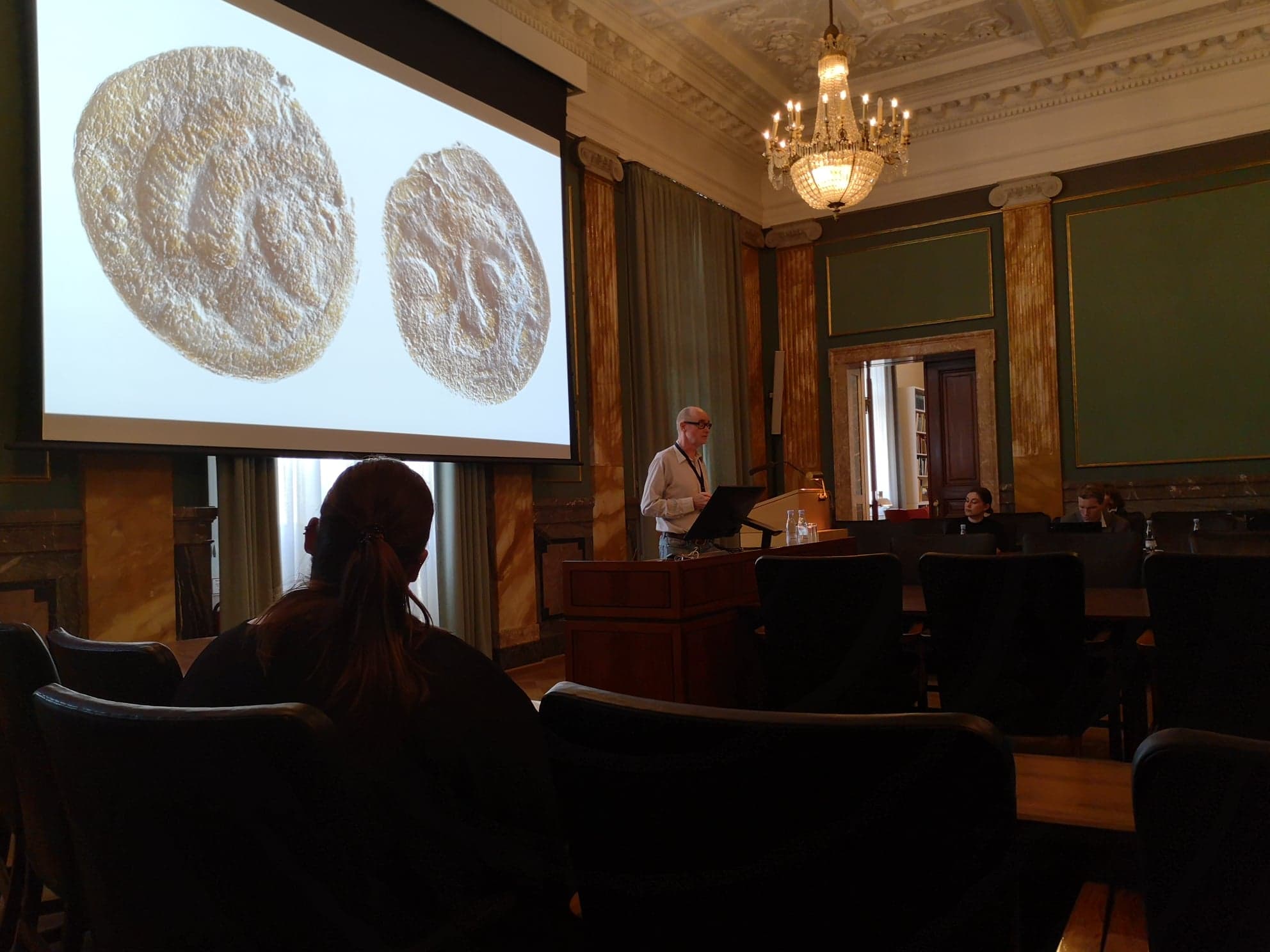The Small Stuff of the Palmyrenes: The Coins and Tesserae of Palmyra
Conference summary by Research assistants Olympia Bobou, Rikke R. Thomsen, and Jesper V. Jensen.




On the 20th and 21st of June, Professor Rubina Raja organized a conference at the Royal Danish Academy of Sciences and Letters, Copenhagen on the coins and tesserae of Palmyra. The conference was sponsored by the Carlsberg Foundation, the Danish National Research Foundation, the Centre for Urban Network Evolutions and Aarhus University.
The conference began with a short introduction by Professor Raja about the Carlsberg Foundation and its importance for Danish research and archaeology. She also provided a historical framework for the collections formed by Carl Jacobsen (now at the Ny Carlsberg Glyptotek) and the long-standing interest of Danish scholars on Palmyra. A crucial figure amongst these scholars is Harald Ingholt who not only published on the funerary portraiture from Palmyra but he was also one of the first people to pay attention to the tesserae.
The first speaker was Nathanael Andrade (Binghamton University). He presented his research on the dies used for Palmyrene coinage and highlighted the problems one encounters when dealing with this material: Lack of contextualized finds (hoards) and circulation of the material in the illicit antiquities market as well as the small size and poor quality of the coins themselves. By focusing on objects from major museums, e.g. the Alexandria hoard (now at Warsaw, National Museum), he was able to establish which dies had been used for the Palmyrene coin production. Based on the coinage found in the Alexandria hoard, Andrade suggests that the production should be dated to around 235 to 273 CE and may have been associated with Odanaith’s rise to power and his military campaigns as well as those of Zenobia.
Nathalia B. Kristensen (Aarhus University) gave a paper on the production, circulation, and function of Palmyrene coins. Based on her Master’s thesis, she presented an overview of the Palmyrene coins found in excavations in Palmyra and those attributed to the city – some of which attributions she questioned. She questioned the previous research on the dating of the coins which was based on quality, and since many of the coins are poorly preserved, this seems to be an inefficient way to date them. Furthermore, Kristensen examined the areas of the Palmyra where the coins were found and noticed a clear lack of coins on the Agora, a place one would expect to find evidence of trade. She also analysed the number of coins found in Palmyra – both the local issues and the provincial coins. She found that almost a third of the total number of coins circulating the city was of different local issues, giving the impression that Palmyra had a primary local production that would have aligned with the local demand for small change after the decline in the production of the provincial bronze issues in the middle of the 2nd century CE.
The presentation of Kevin Butcher (University of Warwick) dealt with the coinage of the wider region. Palmyrene coins seem to differ from Roman imperial provincial coinage and they have been compared to Parthian small bronze coinage. Small bronze coins of low quality without imperial portraits have often been attributed to Palmyra, even though they could have been produced elsewhere. Noticeable, but not unprecedented, the coins found in Palmyra do not include the larger and medium civic issues. Beyond Palmyra, in the wider Northern Mesopotamia, we find coins inspired by Roman imperial coinage (SC coins in particular) or countermarked Roman imperial coins. They date from the 1st to the 2nd century CE, and we can identify two groups – one of large, heavier coins (around 12 g, often countermarked Roman SC coins), and one of smaller coins (around 10 g, often coins referring to SC coinage in their iconography).
The next speaker, Michael Blömer (Aarhus University), gave a paper on civic coins and urban networks. He confirmed what had been said earlier; Palmyra did not mint a large amount of their own coins but when set in a regional perspective, this phenomenon can be seen in other cities as well. What makes Palmyra outstanding is their deviating iconography, choosing not to depict the emperor and symbols or letters that refer to the city the coins were minted in. This only changed in the later period but at that point, the coins of the Roman East had already changed the old patterns. The main discussion evolved around the different influences from the Mesopotamia, Parthia, and the Roman Empire.
Emanuele Intagliata (Aarhus University) shifted the focus from the Roman period to Late Antiquity and early Islamic Palmyra. His paper “Post-Roman Coinage in Palmyra: Two Notes on Circulation and Coin Hoarding” discussed the evidence from the 4th to the 7th century CE. While there was a drastic increase in the production of coins in the 4th century, there are only a couple of finds from the 5th. This can be connected to an economic stagnation that is also seen at many other sites during this period. In the following centuries, the minting activities appear to increase again, however the evidence for this must be considered problematic due to the lack of information of this period. Nevertheless, findings far away from Palmyra (e.g. in Arles or Cartago) confirm the minting activities of the city as well as the well-formed and far-reaching network the city had. The second part of the paper focused on a coin hoard from the 4th century, containing 54 coins, which was found in a pot in the temple of Allat, covered by fragments of an Athena statue. Two suggestions for the existence of the hoard were given: It was a religious act by persecuted members of the Christian community or the coins were buried to make sure they were safe in a period of unrest.
Rubina Raja (Aarhus University) opened up the topic of tesserae, shifting the focus from the coinage to the small terracotta finds that most likely belonged to the banqueting activities that took place in Palmyra. So far, the tesserae have been collected and described but extensive studies are yet to be done. What makes such studies difficult is the uniqueness of the tesserae. They were highly individualized, possibly belonging to a person or group that gave them out as entry tickets to a banquet. This would mean that they only carried meaning at a certain point in time and were discarded afterwards. In her paper, Raja also discussed how the tesserae offered insight into how priests were depicted in the funerary sphere.
Jean-Baptiste Yon (Laboratoire HiSoMA) gave a paper on tesserae and prosopography. In this talk, he emphasized that only four dated tesserae exist. Despite this lack of chronology or further dating, there are ways to come closer to determine when the tesserae were made or used, namely through the iconography and the inscriptions. However, the approach of deciphering the names on tesserae based on other inscriptions are challenging – the genealogies are complicated and names reoccur. It is thus hard to tell if a name, seen in multiple inscriptions, refer to a specific individual or another with the same name. What could be said for sure is that the names correlate with names found in the funerary context. It is also important to mention that half of the tesserae carry an inscription, making it a conscious choice to include these pieces of information on these really small objects.
The second day of the conference started with a paper titled “Divine Representations on the Palmyrene Coins and Tesserae” by Ted Kaizer (Durham University). He highlighted the fact that this conference was the first time that coins and tesserae were studied together since du Mesnil du Buisson’s Tessères et Monnais de Palmyre (1944–1962). Although the two groups of material had different functions, uses, and methods of production, they together give us a better understanding of Palmyrene divine imagery. The coins were the public façade of the city as a whole while the tesserae relate to smaller groups within Palmyrene society. The iconography shows that, even though there was no Pantheon as we know it from Greco-Roman religion, there were distinct Palmyrene religious features: (a) Sacrifices were one way of showing Palmyrene worship and priests were shown in the same way regardless of the deity honoured, and (b) there was no distinction in the way that indigenous and non-indigenous gods were shown. Nearly all the gods worshipped at Palmyra have been identified on tesserae while only a small number of deities have been identified on coins, showing that the tesserae provide us with a greater overview of the religious landscape of Palmyra.
Aleksandra Kubiak-Schneider questioned the use of tesserae in her paper “Palmyrene Tesserae in the Context of Temple Cult: New Reflections and Approach”. Previously, it has been said that they were used as entrance tickets to banquets. This correlates with the origin of the Latin word but, as mentioned earlier during the conference, the word tessera was one chosen by scholars and we do not know what they were called in antiquity. Kubiak-Schneider elaborated on this and concluded that the word ‘token’ would be more suitable. This word carried the meaning of an alternative to coins and could have been used as a way to gain services and benefactions, to commemorate, or even for internal voting within Palmyrene priesthood. She further argued that the inscribed letters “M’KL” should be interpreted as “fermented bread” – an inscription that is often rendered along with the depiction of a jug. This leads to the interpretation that the tesserae, or rather tokens, were a way to distribute the responsibility of food supply for persons concerned. Thus, they should be linked to administration and organisation of the temple cult.
Eivind H. Seland (University of Bergen) presented the evidence for caravan trade on Palmyrene coins and tesserae. While epigraphy, archaeology, GIS and remote sensing, literary sources, and ethnography deliver clear (but scarce) evidence for caravan trade, the tesserae should be examined more thoroughly. He pointed out that, although we know of Palmyra’s importance in the caravan trade, the representations depicting pack-camels are quite limited in number. Camels used for riding or military purposes are more common in Palmyrene art – of which a few examples are seen on coins. Pack camels appear on some of the tesserae; out of 36 known examples 12 can be identified as camels carrying a load.
The last paper of the conference was given by Antonino Crisà (University of Warwick) who presented a tessera discovered in 2010 in the excavations of the University of Milan at the south-west quarter of Palmyra. The tessera was found in the fill of a room (H) in the “Peristyle” house and, thus, cannot be precisely dated. What can be said is that the fill of the room H revealed a Post-Roman use and lots of residual material was found here. The tessera depicts a priest with an assistant on one side while the other side shows a bust and other symbols – e.g. bucrania. The type is known from RTP (RTP 755).
